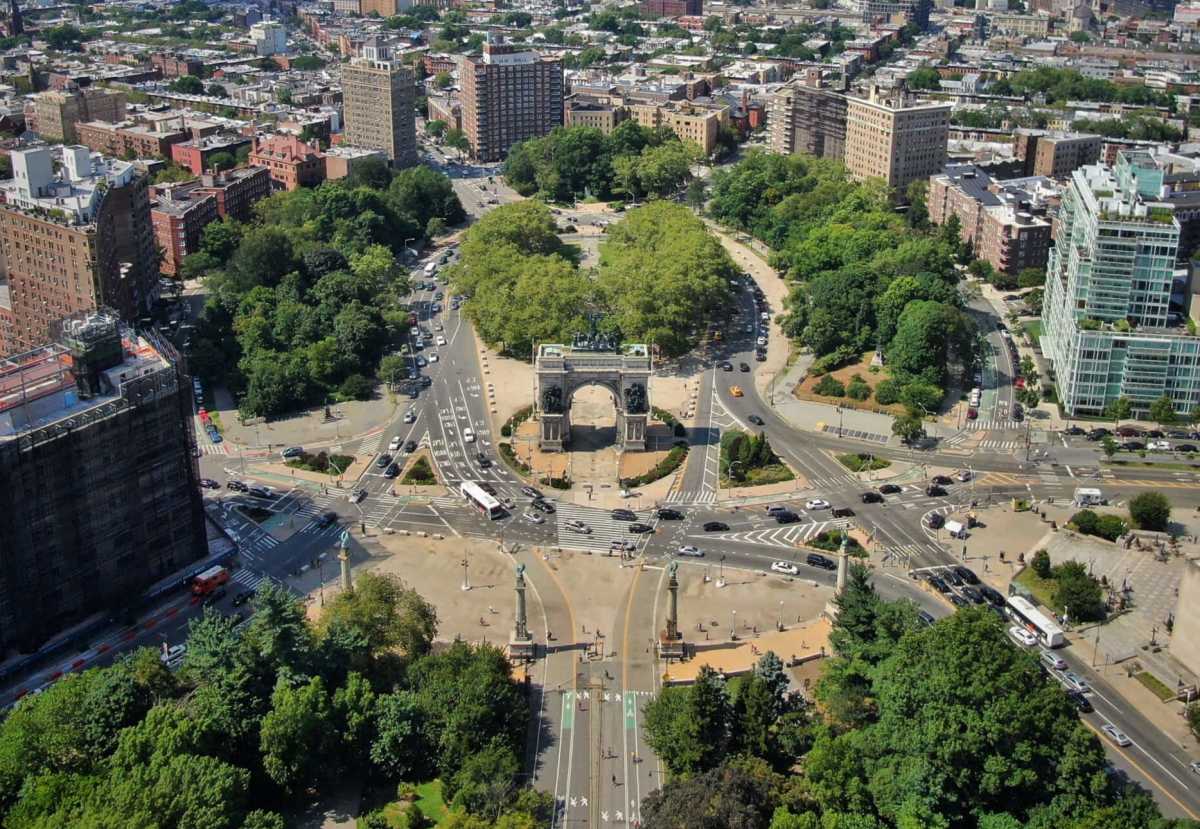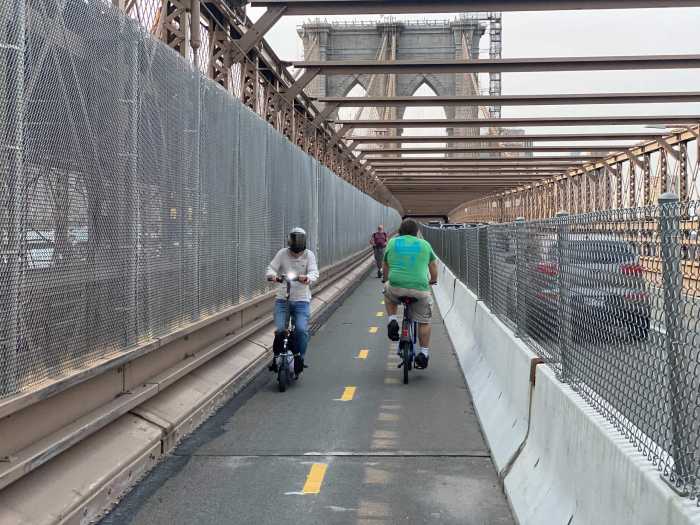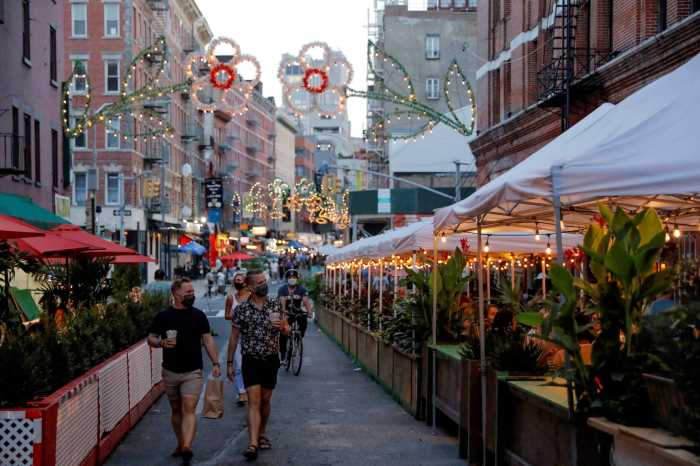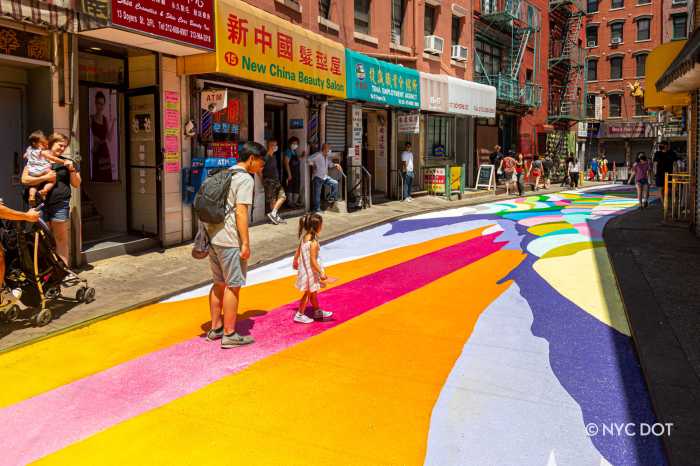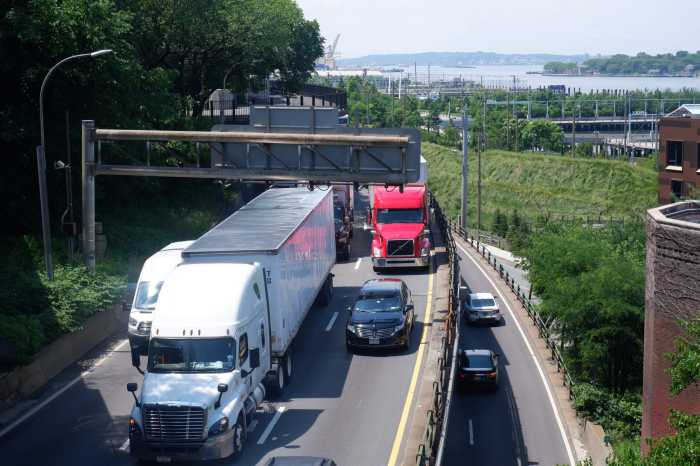The Department of Transportation is considering remaking Brooklyn’s Grand Army Plaza as a car-free public space, in what would arguably be the Adams administration’s biggest shakeup yet to the dominance of the automobile on the city’s streets.
The proposal, first reported by Gothamist last week, citing a senior DOT honcho, is still in its earliest stages, with no plans set in stone and any actual commencement of work likely years away. Community outreach kicked off this weekend: DOT set up a booth at the plaza this weekend and plans a virtual outreach session for Wednesday, Nov. 16. The agency is also collecting feedback from residents via an online survey.
In a press release, DOT acknowledged long-term calls for pedestrianization but noted that no design decisions have yet been made. Outreach on the plaza is part of DOT’s larger “Prospect Heights Public Space Study.”
But even without concrete plans yet made public, any major redesign of Grand Army Plaza would mean fulfilling decades-long dreams of safe streets advocates, who have long identified the massive, chaotic traffic circle as being in desperate need of a change.
“This is huge news,” said Doug Gordon, co-host of the War on Cars podcast and a prominent local advocate for safer streets, on Twitter. “Depending on how it shakes out it could be the biggest and best change to Brooklyn streets in decades.”
“We don’t have to accept the status quo as normal — we can build streets for all by prioritizing people, not cars,” wrote the advocacy group Transportation Alternatives. “Looking forward to this project.”
The plaza, centered on the 50-foot-tall Soldiers and Sailors Arch, sits at the northwestern tip of Prospect Park, home to the Brooklyn Public Library’s main branch and a weekly farmer’s market, and represents the confluence of several major thoroughfares, including Flatbush Avenue, Eastern Parkway, and Prospect Park West.
It is also adjacent to two popular Open Streets, on Vanderbilt and Underhill avenues, which could potentially be connected to the pedestrian plaza, creating a link between restaurants, shopping, and greenspace.
The plaza was designed in the 1860s by Frederick Law Olmsted and Calvert Vaux, fresh off of designing Central Park and now partnering on its Brooklyn equivalent, Prospect Park. The designers intended the elliptical plaza to be a majestic entrance to the park, an oasis away from the city’s hustle and grime. The famous arch came later in 1892, inspired by the Arc de Triomphe in Paris.
The grand entrance vision came to a screeching halt with the advent of the automobile, however, as the plaza turned into the traffic circle it is today. Naysayers objected from the very beginning: the intersection became so notoriously dangerous that in 1927, advocacy groups put up something called the “Death-O-Meter,” a prominent sign urging drivers to slow down and drive safely, with the annual number of fatalities and injuries on Brooklyn streets plastered in print big enough for any motorist to see.
Alas, cars have retained domain over the plaza, traveling through at high speeds in what remains a fearsome spot for pedestrians and cyclists. 139 people have been injured in collisions at the circle over the past decade, including 92 motorists, 26 cyclists, and 21 pedestrians, according to NYC Crashmapper — today’s version of the Death-O-Meter.
In the 2000s, advocates footed a campaign calling for major changes at the plaza, hoping for it to return to what its designers envisioned. The campaign did ultimately lead to some incremental changes, and the permanent ban on automobile traffic through Prospect Park in 2018 allowed the city to co-opt more pedestrian space immediately adjacent to the park. But a marquee proposal, to pedestrianize the section of motor speedway separating the park from the arch, never came to fruition.
One lingering question for a redesign is the fate for bus riders, with the B41 along Flatbush Avenue standing as one of Brooklyn’s busiest, and slowest, buses. DOT has proposed siting a dedicated bus lane along Flatbush to speed up its pitifully slow buses, so unreliable they are forced to compete with hordes of dollar vans, but the B41 potentially having to be rerouted if the plaza is pedestrianized. The MTA is expected to release a draft redesign of the Brooklyn bus network by the end of this year.
Under the Adams administration, the DOT has leaned heavily into street redesigns to reclaim space for pedestrians, cyclists, and straphangers, proposing a number of major projects and beating a goal to implement safety improvements at 1,000 intersections this year.
Earlier this year, the mayor pledged more than $900 million to implement the NYC Streets Plan; Gothamist reported DOT may tap into those funds for potential Grand Army Plaza redesigns.



